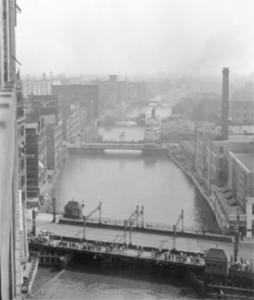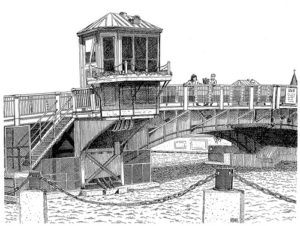CREATION OF THE “MILWAUKEE TYPE” BASCULE BRIDGE
Bascule bridges have one or two movable spans, called a leaf, which rotate vertically on a horizontal, axle-like pin, known as a “trunnion.” The leaf operates much like a seesaw, which is one meaning of the word “bascule” in French. Bascules originated in the medieval castle drawbridge, which provided a water crossing and an effective barricade when raised.
Experimentation with the bascule form began with the need for a bridge that could quickly open and close to facilitate waterway traffic below. Interest in the bridge type began in the early 1890s when Congress gave the War Department the national authority to approve all bridges over navigable waterways and the power to encourage the replacement of those bridges that interfered with the free flow of commerce.
At the end of the nineteenth century, the development of a simple bascule bridge design was pursued in Milwaukee and Chicago in order to enable water vessels to navigate along inner-city rivers while providing crossings for vehicular traffic. As a result, both cities developed similar, yet distinctive, designs for their respective bascule bridges.
The Bridge Division of the Chicago Department of Public Works held a juried competition in 1899 to encourage innovation in bridge design, which was won by Chicago City Engineer John Ericson. The first simple-trunnion bascule bridge utilizing his design was built over the Chicago River in 1902. Designs were developed concurrently in Milwaukee in response to bid requests for the Grand (Wisconsin) Avenue Bridge, and the contract was eventually awarded to the Wisconsin Bridge Company and its simple-trunnion bascule bridge design. The Grand Avenue Bridge was constructed in March of 1902, two months before the bridge in Chicago. The simple trunnion form, now known as the “Milwaukee Type” bascule bridge, was finalized a few years later. Improvements to the design were introduced in the 1904 Emmber Lane Bridge, which became the prototype for future bascules built in Milwaukee.
The simple trunnion bascule bridge is often associated with the City of Chicago, but the “Milwaukee Type” bascule design is believed to have been more widely adopted. According to accounts cited in Historic Highway Bridges in Wisconsin: Moveable Bridges, the “Milwaukee Type” bascule was commonly used due to its ease of design, construction, and maintenance.
The significant difference between the two bascule designs deals with the location of the rack, or operating mechanism that enables the vertical movement of the bridge leaf. The Chicago design utilizes a rear-mounted rack at the back of the bridge leaf, whereas the “Milwaukee Type” features a bottom-mounted rack, below the bridge deck and away from vehicular and pedestrian traffic. In addition, the “Milwaukee Type” utilizes plate girder movable leaves.
MILWAUKEE’S BASCULE BRIDGE EVOLUTION
In 2011, 21 movable bridges were within the City of Milwaukee (13 bascules and 8 lift bridges). Over the last 120 years many bridges have been redesigned, removed, or replaced. Some of the more notable bridges, which illustrate the evolution of Milwaukee’s bascule bridges, are discussed below.
Juneau: The first documented bascule bridge in Milwaukee was a wooden structure along today’s Juneau Avenue, built in 1840. It was the infamous bridge destroyed by residents of Juneautown: the incident that ignited Milwaukee’s Bridge War. Several replacements later occurred, the last being the bascule bridge erected in 1953-1954, which was replaced in 2012 with a lift bridge. For more information, please visit Replacing the Juneau Avenue Bridge.
Clybourn: The first steel bascule bridge in Milwaukee was constructed at Clybourn Street in 1896. The structure maintained a constant center of gravity and the number of moving parts was kept to a minimum. The design was never patented, making it easy to adapt and modify.
Emmber Lane: The final modification that led to the creation of the “Milwaukee Type” Bascule (see above) appeared with the Muskego Avenue/Emmber Lane Bridge of 1904. It was one of the first of this type in the country and was used across the nation due to its simplicity and cost effective operation. This form became the standard in Milwaukee and all 13 spans built in the city before World War II were of this type. The bridge was replaced with a modern bascule bridge in 2000.
State Street: There have been two bridges crossing the Milwaukee River at State Street. The first was an iron swing bridge built in 1871. The second was a bascule bridge constructed in 1924 that was recently rehabilitated. The State Street Bridge is significant as the first bascule bridge designed to meet aesthetic concerns. More attention was given to the aesthetics of the State Street Bascule Bridge than its predecessors, possibly due to the fact that more attention was directed at the waterways as important features of the city and not just as the dreary backwater alleys they had become in the nineteenth century.
Kilbourn Avenue: Unlike other bascule bridges in Milwaukee, the West Kilbourn Avenue Bridge did not replace an existing bridge at the site. The bridge was completed in 1929. Originally planned with two copper-clad operator’s houses almost identical to the State Street Bridge, the Public Works Commissioner desired a grander statement for the avenue that would serve as the main thoroughfare to City Hall. The bridge was designed in the Neoclassical style and featured extensive use of limestone and decorative features that reflected the City Beautiful Movement of the early twentieth century.
THE DECLINE OF THE BASCULE
Following World War II, the volume of boats transporting goods continued to decrease, especially on the Milwaukee River, making bascule bridges less necessary than they had been. Over the course of the last 20 to 30 years, many of Milwaukee’s historic bridges and viaducts have been replaced; however, several have been rehabilitated and retain their original historic features.

Lift bridges, which had their antecedents in the late nineteenth century, are increasingly found along the Milwaukee River due to the end of commercial shipping in the 1960s. This type of bridge, as its name implies, has a center portion that raises vertically to allow for the passage of boats. It is less complex mechanically than the bascule and costs less to operate. With a clearance of typically 25 feet, the vertical lift bridge is well suited to the small pleasure craft that frequent downtown waterways.
For a full, current list of Milwaukee’s remaining movable bridges please visit BridgeHunter.com.
*Proceed to the next section: Replacing the Juneau Avenue Bridge[/wr_text][/wr_column][/wr_row]



